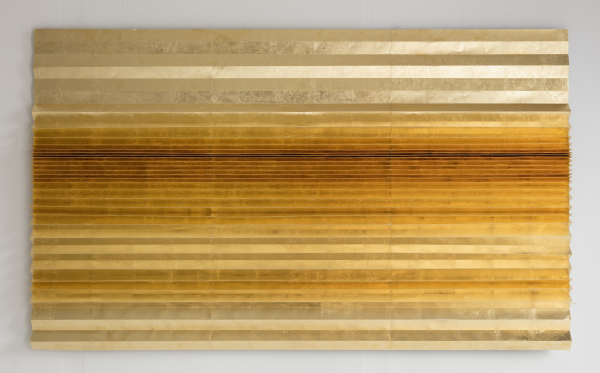
“To work with textiles is to work with light and patterns,” says Denmark-based designer Astrid Krogh, whose sculptures transform everyday spaces into glowing, dynamic environments. Fascinated by the interplay of textile and light, Krogh has modernized the centuries-old technique of tapestry weaving with the use of thoroughly modern materials including neon, reflective metals, and optic fiber.
“I am fascinated by the change of light in the sky,” says Krogh, whose pieces often capture the ever-changing striations of hues found in the natural world. Take, for example, My Golden Horizon, constructed from a single sheet of paper coated with gold leaf. With strategic pleats and folds, Krogh reflects and diffuses the ambient light that surrounds it to create gleaming streaks and bands that reproduce the luminosity and myriad hues of the sun setting over the water’s edge. The effect is as ethereal as the natural phenomenon itself. “I am very conscious about what light does to its surroundings,” Krogh says.
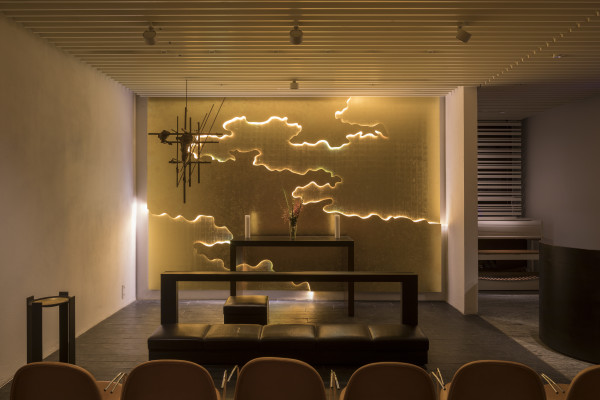
Most recently, Krogh found inspiration in the infinite associations of golden light with spiritual presence when designing Lysvaeld, an alter backdrop commissioned for the prayer room in Copenhagen’s National Hospital. Aware that “the brilliance of golden light is believed to represent the Divine presence on Earth, illuminating the skies with the radiance of heavenly realms,” Krogh says, she began by consulting religious texts for descriptions of heavenly light and then captured its golden tones in layers of gold leaf. Subsequently, large-scale graphic shapes, illuminated by the soft light produced by amber LEDs, were cut out and hung to mimic the outlines of clouds. “People do not look into a horizon but they look at light behind a cloud, Krogh explains. “That is where the hope for the future comes into ‘the picture.’” The integrated lighting gently transitions from soft to intense and back again, adding a subtle sense of movement to the otherwise static surface. The resultant golden glow gives the wall a gentle luster and warmth as if rays of summer sunshine are streaming into and over the room.
While much of Krogh’s inspiration comes from the natural world (“especially in Denmark you have a variety of lights constantly,” she says), artificial light holds its own fascination for the artist. Take neon, for example. A product of gas and glass tubing, she says, “it is there and it is not there.”
“I came to see you can weave with light itself,” Krogh says of earlier pieces such as the IKAT series in which she weaves thousands of multicolored optic fibers. Inspired by the “small, unprecise changes” of pattern and color found in ancient Kilim carpets, Krogh’s weavings seek to reproduce spectrums of color with similarly understated transitions. “For me, it is like a repeat, but I’m interested in the kind of pattern that is not the exact repeat,” she explains.
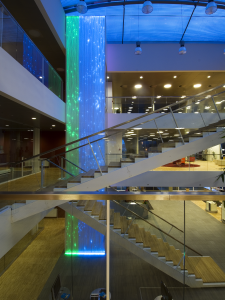
“It’s a meditative rhythm but it’s unpredictable, too. That’s what makes the pattern alive.” As with traditional colorways, she says, the fibers’ light serves as an “imaginary dye” whose subtle transitions shift and merge. Later pieces such as Lightfall and Lightmail employ the same technique to create massive installations with the capacity to energize or calm densely populated public spaces with their spectrums of changing color.
Merging such subtle transitions requires immense precision and the capacity to wield composite patterns that can number into the millions. However, Krogh’s final works are frequently so understated in their execution they appear as anything but complex. Her formidable installation Polytics, commissioned for Copenhagen’s Danish Parliament building, provides an ever-evolving play of color and form variations to passersby. Constructed of 10 different pattern parts, their combined variations number in the millions. Changing patterns every 45 seconds, the work is programmed according to the amount of time it takes a visitor to traverse the hallway it inhabits.
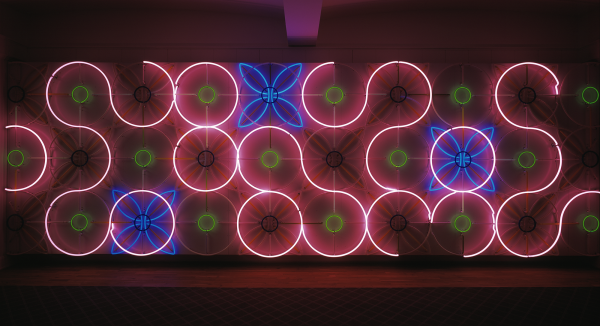
Taking a page from the German concept of Gesamtkunstwerk, all of Krogh’s public works begin with a contemplation of the site itself. “I really listen to the architecture,” she says about approaching a commission. “It’s very important to read the space.” In this way, just as Krogh weaves material and light, her works achieve “a synergy with their surroundings, a back and forth” or interplay between the installation and the world around it.
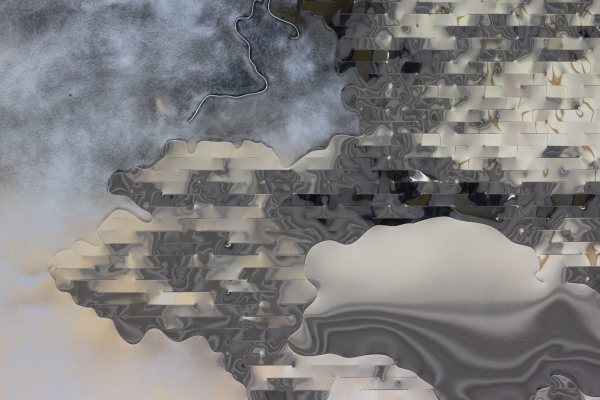
Krogh’s deft weaving of material with its space may be no more apparent than with Cloud Illusions/Paris installed in Longchamp’s couture flagship store on the Champs Elysees. Defining the central staircase, the 10-by-10-meter transparent installation provides a dynamic and interactive focal point. Incorporating embossed and perforated aluminum forms into architectural glass, the metal’s composite mirror surfaces reflect and refract whatever light and color it encounters (“as clouds do in the sky,” Krogh says of the effect). “If a woman in a red dress and green hat walks by, that’s what will be reflected,” Krogh explains. It is a particularly fitting feature for an industry defined by ever-changing silhouettes and palettes.
Merging the traditional and contemporary, ethereal and bold, Krogh’s body of light sculptures reads like a study of transformation itself. “Things are changing, times are changing,” Krogh says of her approach to creating art. “There are new techniques, new materials, new expressions to work with. You have to be able to incorporate that into your work. It’s very inspiring, actually.”